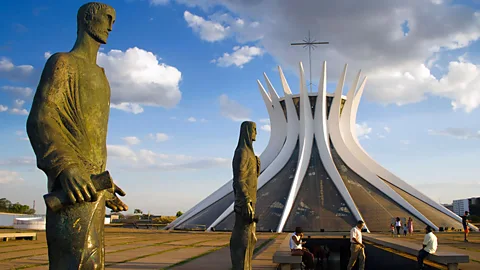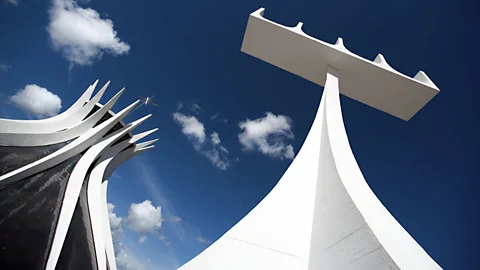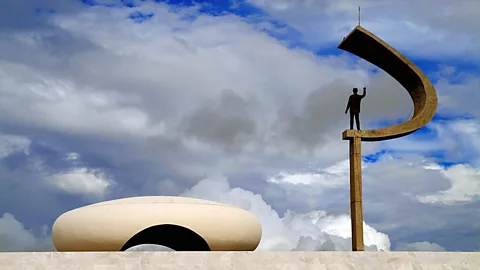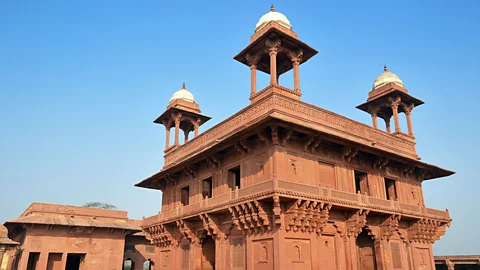Brasilia: Building a city from scratch

Oscar Niemeyer designed a metropolis where none had stood previously when he envisioned Brazil’s capital. Jonathan Glancey looks at the success rate of ‘new cities’.
The view from high hotel windows along Brasilia’s Monumental Axis, or principal street, is surely one of the most surreal to be had of any major city. Laid out below and beyond is a grid of ambitious, geometric avenues lined with modern buildings of a distinctly rational order. The focus here is not on the cathedral, shaped in the guise of a highly formalised crown of thorns but on the compelling Congressional Palace with its pencil thin and close-coupled twin towers soaring above the Senate and Chamber of Deputies.
Just beyond is the city’s most beautiful building, the Alvorada Palace, jutting out on a peninsula into the artificial Lake Paranoa shaped like a bird or bow. You are left in no doubt that Brasilia is a city of government, of executive power, administration and law – and of no fewer than the 126 foreign embassies slotted into its striking modern buildings, too.
From those hotel windows, this new city looks like a giant architect’s model. Despite its obvious coherence, it appears to lack shops, markets, street life and a sense of humanising, quotidian life. And, to a large degree, this is true. If you happen to be a fan of late 1950s and early 1960s modernist architecture, you will find your concrete El Dorado here. There is no doubt that, in their own terms, the parliamentary, government, diplomatic and legal buildings, together with the nearly identical rows of superquadras, or apartment blocks, that serve them, represent some of the world’s finest design of that period. They should do, for nearly all of them were designed by a single architect, the legendary Oscar Niemeyer, who died in 2012 shortly before his 107th birthday.

Together with the town planner Lucio Costa and landscape architect Roberto Burle Marx, Niemeyer designed and built the core of Brasilia – a capital city promised in Brazil’s 1891 republican constitution – in just 41 astonishingly productive months. The impetus had come from Juscelino Kubitschek, the dynamic Brazilian president, who took power in 1955 promising “fifty years of prosperity in five”. It was a daring boast, and yet Kubitschek performed heroically, doing much to lift Brazil into a self-consciously modern era symbolised by the very look of Brasilia.
Beautiful…but liveable?
Kubitschek’s design team camped out for the duration in a purpose-built cabin – it is still there today – where the president himself had a bedroom. The city rose with breathtaking speed, making maximum, and optimum, use of cheap and readily available concrete, a material that Niemeyer, almost more than any other architect, transformed into a notably, and perhaps unexpectedly, sensuous medium. The glorious curves of his characterful buildings – they belonged very much to Brazil despite being designed in what was thought of as an “international” style – brought a vivaciousness and glamour to Modern Movement design. Niemeyer has even said that his designs were influenced by the curves of the bodies of women he could see displaying themselves on Copacabana Beach from his studio in the heart of Rio de Janeiro.
But, although Niemeyer, Costa and Marx were a brilliant and prolific team, they were unable to give Brasilia a life beyond that of a government and civil service city. In fact, ever since the new capital was inaugurated in April 1960, its airport has been crowded on Friday afternoons as very many of those who live and work here in the week make a hasty weekend exit to the very human delights of Rio, which had been the capital of Brazil from 1763 to 1960 and still feels as it is the real thing today.
Brasilia was planned for a population of just 500,000, but today this has risen to 2.8 million and more than four million including satellite towns. There are several suburbs – of these distinctly unplanned settlements – where you will find a life and a spirit very different to that of the elegant set-piece architecture and rational street plans of central Brasilia itself. Where, though, in a traditional city these satellite settlements would form a part of an urban whole – the ‘east ends’ of a city – here they are cut off from the core of the capital.

This, though, has been true of many of the attempts made, over thousands of years, to create ideal planned cities whether by monarchs, emperors or republican governments. The truly great cities that have thrived over centuries and even millennia – Rome, London, Shanghai among them – have done so because they have developed largely organically and with all strands of their complex lives woven together, if not ideally then intimately and humanely. They have been built where physical, and trade, conditions have been more or less ideal and where there has been a plentiful supply of water and easy access to the sea even when set, like London, miles from the oceans’ waves. As a result, traditional cities are also resilient entities, capable of expanding and contracting with rising and falling tides in trade or with political fortunes or even natural catastrophes like plague and fire.
Human touch
Highly planned, ideal cities, however, are – as history tells us in no uncertain terms – more brittle and less able to adapt to circumstances than their unplanned, or organic, counterparts. No matter how much – Canberra, Ottawa, Chandigarh and New Delhi try – and despite the occasional magnificence of their principal buildings, they seem, resolutely, to lack the warmth and human spirit that characterises Sydney, Calcutta, London and Rio de Janeiro. Just as we cannot create a perfect person,the perfect city is apparently beyond us.
Think of the case of Fatephur Sikri, the magnificent new capital city created by the Mughal Emperor Akbar in mountains of crafted red sandstone in the late 17th Century. It was abandoned just a few years after completion because of a lack of water. Before and since, ideal cities have been just that: ideals, or ideas that have been impossible to live up to. Some, of course, have been slightly insane from the beginning like the vision of a new city of a million people on Tokyo Bay dreamed up by the American inventor Buckminster Fuller for the Japanese media mogul Matsutaro Shoriki in the early 1960s. This was to have taken the form of a titanic floating tetrahedron. Here was one of those science-fiction-style visions of the ‘60s that imagined us living hermetic lives in futuristic megastructures when, in reality, most peopled preferred to walk in city streets and squares open to sun and sky.

The Shoriki city – the unrealised plan ended with the mogul’s death in 1966 – was one of many envisaged by wealthy businessmen and corporations in the 20th Century. Today, a large number of ideal cities are planned in the Middle East – the products of business corporations. The $20bn, two-square-mile Kingdom City in Jeddah, planned around the world’s tallest building, the Kingdom Tower, has been commissioned by the Kingdom Holding Company owned by Prince Al-Waleed bin Talal. Successful, and likeable, cities are, however, the product of the dreams, ideals, ventures and gambles of many different coalescing and clashing businesses, individuals and other bodies. When designed for a single purpose, or by powerful individuals alone, “ideal” cities tend to fail.
Partly, this is a question of scale. It is possible to plan small ideal towns as found in Renaissance Italy, the Cambrian coast of Wales at Portmeirion, a romantic holiday town designed by the architect Sir Clough Williams-Ellis, or in the depths of Dorset where Poundbury waves a flag for the traditional architectural values of this new town’s patron, the Prince of Wales.

Cities are much bigger, more complex, more diverse and less controllable entities than these. They are at their physical best, perhaps, when attempts are made to plan them – with fine new buildings, streets, squares and public services – even as their industry and sheer vivacity makes planning them as difficult as finding a natural spot to sit down and relax in Brasilia.
And, yet, what a magnificent achievement Brasilia was, in so short a time, conveying to the world that here was a country at the dawn on a new era ready to take on the world. Today, alongside Venice and Bath, this monumental and compelling modern city is a Unesco World Heritage Site – although as Oscar Niemeyer told me, “Brasilia? It was a blast!”
